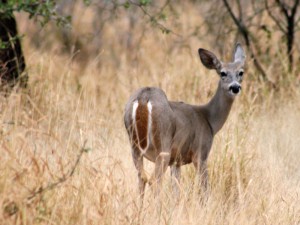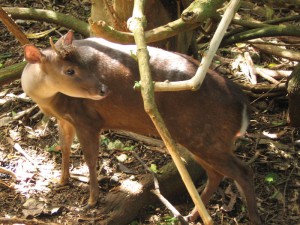White-tails and Brockets

By Jack Ewing
Hunters in general and deer hunters in particular are one of the most serious causes of forest fires in Costa Rica, especially in the tropical dry forests of the northern Pacific part of the country. Every year during the dry season forest fires rage in many parts of the country, but the Santa Rosa National Park in Guanacaste is usually one of the hardest hit. Even though it is illegal to hunt in the park poachers continually pursue the deer there. Since animals have a natural fear of fire, the hunters start a blaze in a place where they think it will scare the deer into running in a particular direction. Their buddies will be waiting, rifles ready, where they think the deer will emerge from the burning forest. The problem is that the fire has a mind of its own, and doesn’t always burn in the direction the hunters want it to go. And, of course, it usually gets out of control and burns vast areas of forest destroying not only the vegetation, but also the wildlife that lives there.
The main species of deer that the poachers hunt are white-tailed deer. According to The Mammals of Costa Rica by Mark Wainwright, white-tailed deer (Odocoileus virginianus) are native to most of the lower elevation forests of Costa Rica. That includes the central and southern Pacific regions. However, over the years I have interviewed many of the pioneers who settled the area between the Savegre and Terraba Rivers. Some of them had been in the area since as long ago as 1920. During the interviews I always ask about the wildlife from years past, what types of animals they hunted for food, and which animals were common then but are locally extinct now. The red brocket deer (Mazama americana) was often mentioned, but nobody ever reported seeing a white-tailed deer in this region until the late 1970s.

As a teenager in the 1940s, the late Ramón Segura from Pacuarito was an avid hunter of red brocket deer. Even more than the taste of the meat he loved the excitement of the hunt. He particularly enjoyed hunting at night. Upon seeing two bright red embers of reflected light Ramón knew that he was looking at the deer’s eyes and would aim right between them. His nocturnal hunts came to an abrupt halt one night when he shot right between two big red eyes and killed his mare. She was the only mare he owned, and her loss really hurt. Ramón was an excellent marksman and was once invited to participate in a deer hunting competition in Guanacaste. He didn’t win the competition, but really enjoyed the trip and the hunt. “The deer up there are different than the little brocket deer we have here,” he told his friends. “They’re bigger and lighter colored. The Guanacastecos call them white tails.”
1978 was the year when Don Eliecer Castro went on an excursion to the northwestern Provence of Guanacaste where Ramón had competed in the deer hunt 30 years earlier. As they were driving through the Nicoya Peninsula he was surprised and delighted to see that some of the ranchers had captive deer. He was fascinated by these big, light-colored deer, so different from the red brocket deer on his ranch near Matapalo. Don Eliecer has always had a passion for nature, and has brought many rare species of fruit trees and other plants to our region. When he saw the captive deer, he knew he had to have some on his ranch. He bought a young buck from a man in Nicoya and a doe from a family that had her tied up alongside the road in front of their home near the town of Philadelphia (Guanacaste). He loaded his new purchases in the back of his pick-up and brought them home to Matapalo.
Don Eliecer built a large pen for the two deer and made sure they had plenty to eat. Both deer were semi-tame and adjusted easily to the living conditions at their new home. It turned out that the doe was pregnant when Don Eliecer bought her, and she soon gave birth to a healthy female fawn. Under captive conditions with plenty to eat the deer reproduced prolifically, each doe producing one or two fawns every year. Within a dozen years, Don Eliecer had so many deer that feeding them was becoming a problem. Keeping them captive was also a problem, and quite a few of the white-tails escaped. Eventually, under pressure from the wildlife department, Don Eliecer turned them all loose.
In the wild the deer developed a taste for beans and corn and soon got into lots of trouble with the local farmers who shot them on sight. Nevertheless, the deer population continued to increase and spread throughout the area. I remember one morning in the late 1980s when an excited truck driver came to our house and wanted to borrow a rifle. “There’s a deer out in your pasture,” he exclaimed, “and I want to shoot it.” It was the first time anyone had seen deer on Hacienda Barú which is 12 km from Don Eliecer’s ranch. I told him that I had a rifle, but I wouldn’t lend it to him. “If you do anything to harm that deer,” I yelled at him, “I’ll use the rifle to shoot you.” Later that same morning the same driver saw a deer in a pasture on Don Eliecer’s ranch, and again went to the house and asked to borrow a rifle. Don Eliecer took him out to the deer pen and showed him half a dozen captive deer. “While you’re at it I suppose you’ll want to kill all of those deer too.” he exclaimed angrily. The driver hung his head, and walked back to his truck.
Today white-tailed deer are often seen throughout the area between the Barú and Savegre rivers. I get a couple of videos of deer on my trail cameras every year, and the Hacienda Barú park rangers and guides report occasional sightings. Pumas have also become well established in the area, and deer are one of their favorite prey animals. To see a great video of a puma with a deer it has killed go to YouTube and type the words “Puma at the Firestone Center” into the search box. This video was taken with a trail camera at the Firestone Center for Restoration Ecology which borders Hacienda Barú.
Considering that all of these white-tailed deer are supposedly descended from three individuals, it is amazing that such a healthy population exists in the area today, 37 years after Don Eliecer brought the buck and the pregnant doe from Guanacaste. Normally continued mating amongst related individuals results in what is called inbreeding degeneration, the first sign of which is infertility. This is followed in future generations by physical defects and lack of resistance to disease and environmental stresses. Obviously this isn’t the case with these white-tailed deer which have reproduced prolifically, evaded hunters and predators, and have a healthy population that seems to be growing. All of these factors tend to indicate that there were other individuals contributing to the gene pool. Possibly some wild white-tailed deer migrated into our region, and mixed with the ones that were descended from Don Eliecer’s deer. With all of the natural habitat that has been restored within the Path of the Tapir, and other biological corridors, this is a strong possibility. Only with extensive DNA testing will we ever know for sure.
Red brocket deer are slightly smaller than the white-tails, 25 kg (55 lbs.) as opposed to 30kg (66 lbs.) and have a shorter body, 110 cm. (43 inches measured from the tip of the nose to the base of the tail) as opposed to 130 cm. (51 inches) in the white-tailed deer. The Central American sub species of white-tailed deer are smaller than the ones in North America. Red brocket deer aren’t found in North America.
Unlike the white-tailed deer, the red brocket deer, are native to this region. Every old timer that I have interviewed reported seeing them and hunting them. One man says he remembers a time when it wasn’t unusual to see them in large groups, and that he witnessed two hunters from San Isidro kill about 20 in a period of an hour. “What a waste,” he said. “They only took one home for the meat and left the others for the buzzards.”
As the name implies the red brocket deer are reddish in color, and the males have two spike antlers that slant slightly backwards like those of a goat. In fact the deer are called cabros de monte or cabritos in Spanish, meaning jungle goats or little goats. The red brocket deer’s vulnerability to hunters is due to two unfortunate behavioral traits, their habit of foraging at the edge of the forest where they are quite visible, and their tendency to bolt only a short distance when startled and then freeze. That is why the two hunters from San Isidro were able to kill so many without the others running off. The deer just stood there stock still while the hunters shot them one at a time.
Hacienda Barú guide Juan Ramón Segura sighted a red-brocket deer on the hacienda in 1989, and biologist Mason Ryan sighted another in 1996. That same year Juan Ramón and I saw tracks and droppings near the location of Mason’s sighting. To my knowledge there have been no sightings since that time. Nor have I heard of any in other parts of this region. I have six trail cameras distributed through the forests of Hacienda Baru, and have never captured photos or videos of a brocket deer. It would be a shame if these once abundant creatures have become locally extinct.
If any of you readers have seen a red brocket deer between the Savegre and Terraba Rivers, please let me know about it. I would also be interested to hear of any sightings of white-tailed deer as well especially north of the Savegre River or south of the Barú. I can be contacted at, [email protected].
